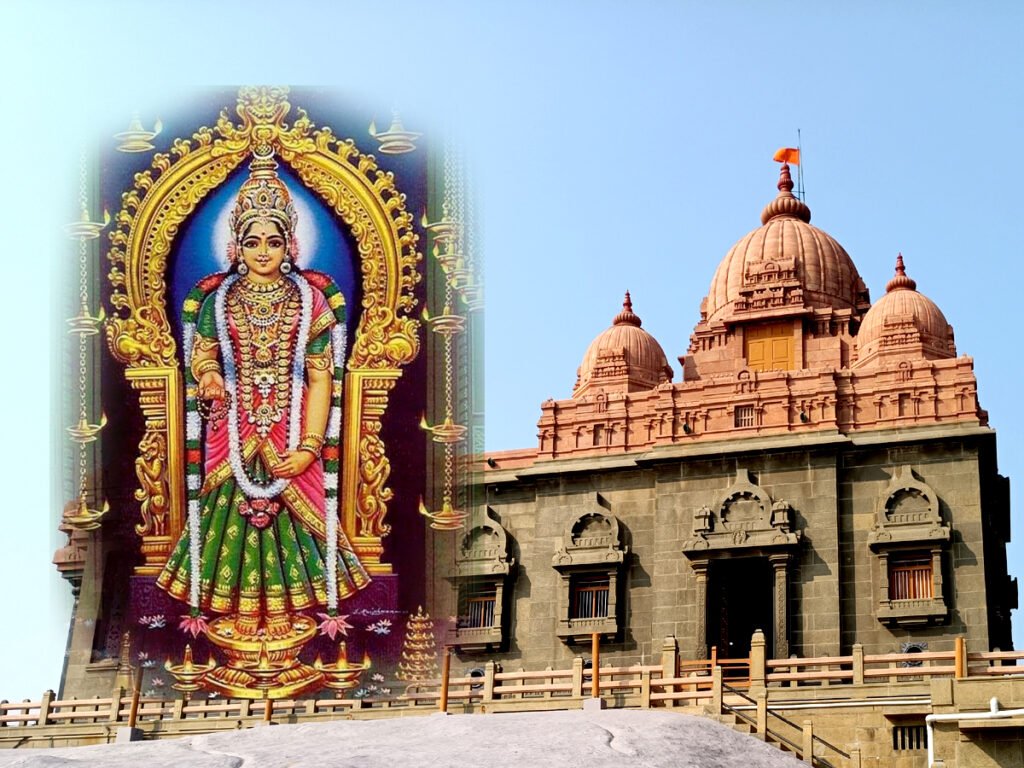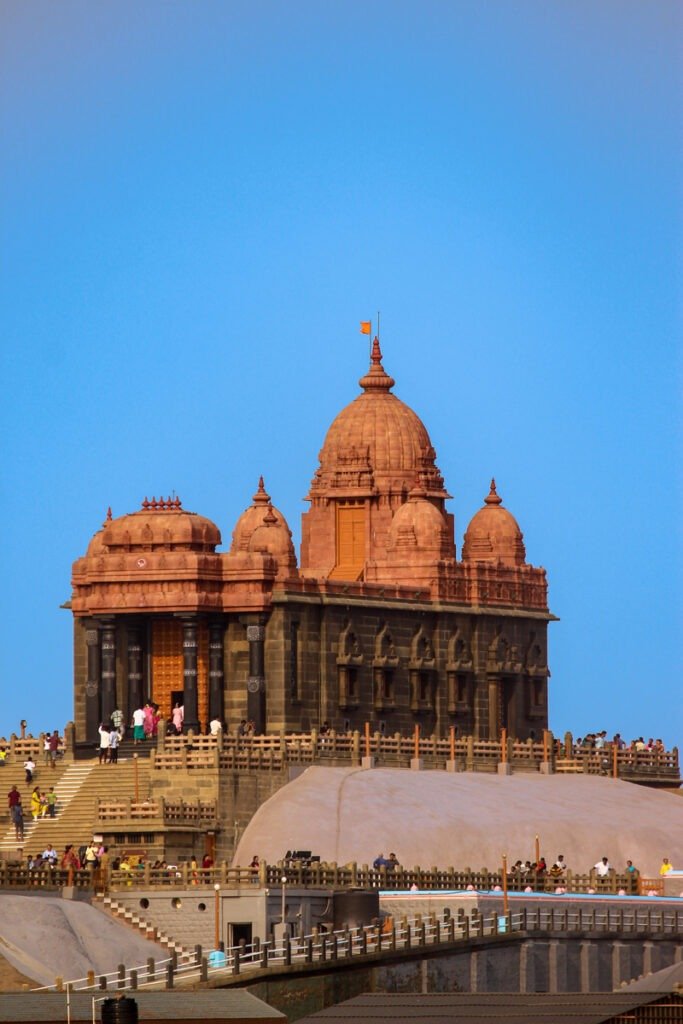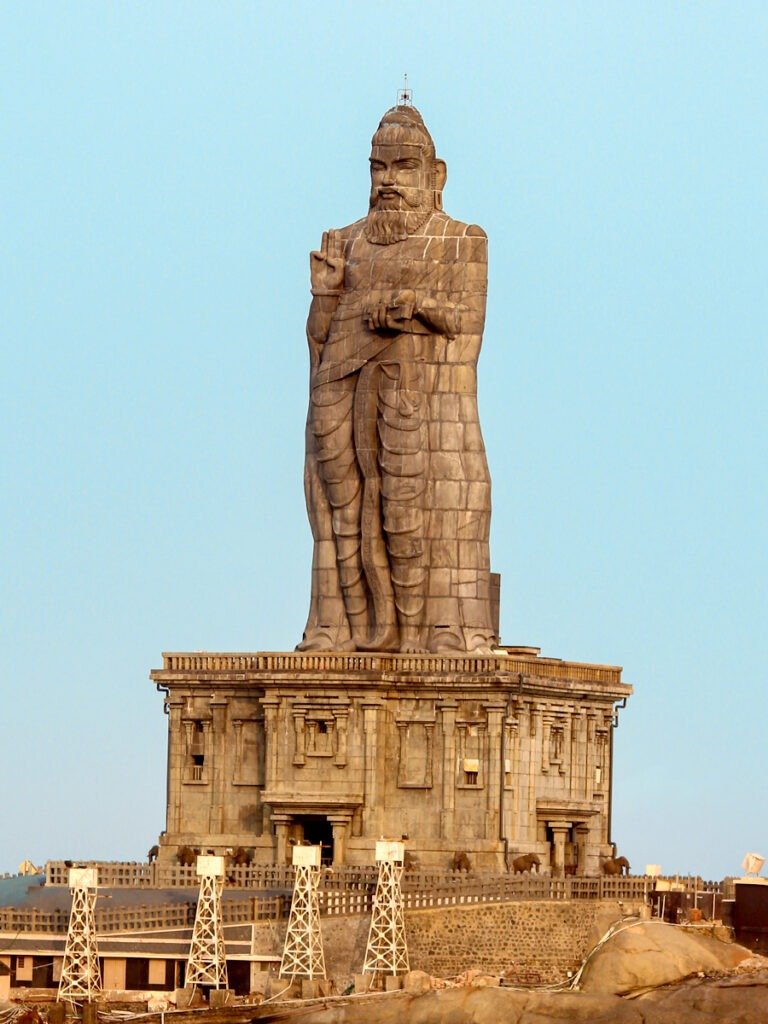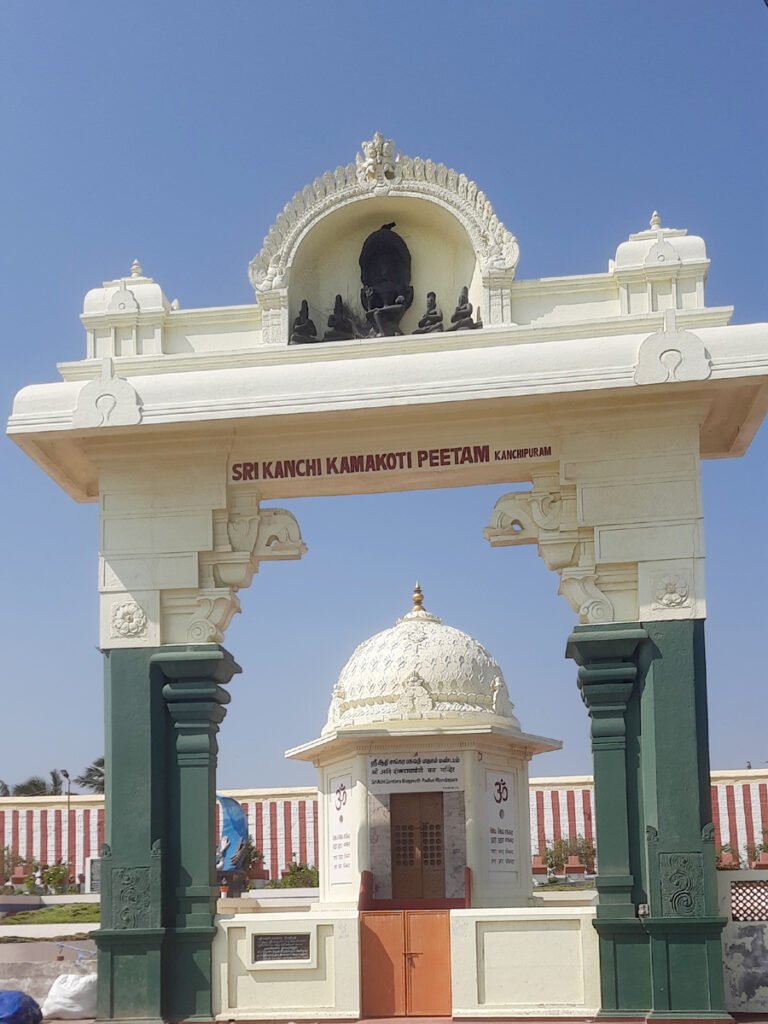Kanya Ashram Kanyakumari Temple
Kanyakumari Temple: Kanyashram of Balaambika or Kanya Ashram Kanyakumari is one of the Shakti Peeth located in Cape Kanya Kumari, Tamil Nadu. Goddess is popularly known by the name “Bhagavathy”. In other regions, the goddess is also called with the names Kanya Devi, Kanya Kumari, Badrakali, etc.

Contents
- 1 History of Kanyakumari Temple:
- 2 Legend of Kanya Ashram Kanyakumari Temple:
- 3 Places to visit near Kanyakumari Temple:
- 4 FAQ:
- 4.0.1 What is the Kanyakumari Temple?
- 4.0.2 Where is the Kanyakumari Temple located?
- 4.0.3 What is the significance of the temple?
- 4.0.4 What is the architecture of the temple like?
- 4.0.5 What are the main festivals celebrated at the temple?
- 4.0.6 Can men enter the inner sanctum of the temple?
- 4.0.7 What is the best time to visit the Kanyakumari Temple?
- 4.0.8 Are there any other attractions near the Kanyakumari Temple?
- 4.0.9 Is there an entry fee to the temple?
- 4.0.10 Are there any specific dress code and rules for visiting the temple?
- 5 How to reach Kanyakumari Temple:
- 6 Google Maps:
Significance:
According to the mythology Daksha yagna and Sati self-immolation, it is the holy place where the “Back part” fell down. Devotees believe the goddess removes the rigidity of the mind and many devotees say that they feel tears from their eyes after praying to the goddess.
History of Kanyakumari Temple:
Ancient Origins: The history of the Kanyakumari Temple can be traced back to ancient times. The temple is mentioned in various historical texts, including the Sangam literature, which dates back to the 4th to 5th centuries CE. It is believed that the temple has been a place of worship for over a thousand years.
Mythological Significance: The temple is associated with several Hindu myths and legends. According to one popular legend, the goddess Kanyakumari was supposed to marry Lord Shiva, but the wedding was disrupted due to a trick by the demon Banasura. The goddess, who was in the form of a young virgin, decided to remain celibate and meditate at Kanyakumari until the right time for the wedding. She is believed to still be in meditation in the temple.
Unique Location: The Kanyakumari Temple is famous for its picturesque and unique location at the confluence of the Bay of Bengal, the Arabian Sea, and the Indian Ocean. The geographical significance of the temple adds to its spiritual aura.
Architectural Style: The temple showcases the architectural style of South Indian temples, with a towering gopuram (entrance tower) and intricate stone carvings. It features vibrant and colorful sculptures and artwork that depict various Hindu deities and mythological stories.
Festivals and Pilgrimage: The temple hosts various festivals and events throughout the year, drawing pilgrims and tourists alike. The Navratri festival, during which the goddess is believed to be adorned in different forms each day, is a major celebration. The temple is a significant pilgrimage site for devotees of the goddess Kanyakumari.
Renovations and Modern History: The temple has undergone renovations and improvements over the centuries. In recent times, the temple has seen modernization efforts to accommodate the growing number of visitors. However, these changes have sometimes sparked controversies and debates about preserving the temple’s historical and cultural authenticity.
Read More: Tripura Sundari Temple in Tripura.

Legend of Kanya Ashram Kanyakumari Temple:
As per the Vedic books, there lived a demon named “Bana”, he ruled this place and was named a great king. In greed to acquire the whole universe, he did penance and obtained a boon from Lord Brahma not to be killed by any source. lord, Brahma said “This boon cannot be given, every creature in this universe who has birth will have death” Then Bana asked for a boon that he should be killed only by a Kanya (adolescent virgin girl).
With the pride of the boon, he started creating havoc in all universes. He captured the throne of Lord Indra and other gods. He imbalanced nature, as Bhagavathy is the form of nature, she manifested from “Aryavartha” to kill Bana.
Goddess had immense devotion towards Lord Shiva from her childhood, to her devotion Lord Shiva decided to marry her. The marriage muhurth was at Brahma Muhurtha (early morning) and all arrangements were made for the marriage occasion. Sage Narada arrives in the form of Cock and gives a sound and misguides lord Shiva who is on the way to the marriage ceremony. He says “You are late and the sun is about to rise”, by listening to his words lord returns back.
Goddess Kanya Kumari, who is waiting for the ceremony waited for the whole day, disappointed with the incident she pledges a wow to keep Kanya till the end. After days passed, Bana under pride couldn’t recognize the goddess as the almighty started luring goddess. In anger, the goddess sloughs Bana, moments before death Bana urges the goddess to remove all his sins and remain here forever with her divine presence.
Read More: Manasa Shakti Peeth Manasa Sarovar

Places to visit near Kanyakumari Temple:
Vivekananda Rock Memorial: This iconic structure is situated on a small island and can be reached by a short ferry ride. It is a tribute to Swami Vivekananda, who meditated here, and offers stunning views of the confluence of the Arabian Sea, Bay of Bengal, and Indian Ocean.
Thiruvalluvar Statue: Adjacent to the Vivekananda Rock Memorial is the Thiruvalluvar Statue, dedicated to the famous Tamil poet and philosopher Thiruvalluvar. The statue is 133 feet tall, representing the 133 chapters of his famous work, the Thirukkural.
Gandhi Mandapam: This memorial is built in honor of Mahatma Gandhi, and it is where his ashes were kept before immersion in the sea. It’s located near the temple and offers a great view of the surrounding area.
Kanyakumari Beach: The town has a beautiful beach with multicolored sands, where you can relax and enjoy the breathtaking sunsets.
Suchindram Temple: Located about 13 km from Kanyakumari, this temple is renowned for its impressive 18-foot Hanuman statue and intricate stone carvings.
Padmanabhapuram Palace: Situated about 20 km from Kanyakumari, this wooden palace is a fine example of traditional Kerala architecture and offers a glimpse into the region’s history.
Kovalam: This popular beach destination is about 90 km from Kanyakumari. It’s known for its pristine beaches, vibrant nightlife, and water sports.
Mathur Aqueduct: Located approximately 15 km from Kanyakumari, this aqueduct is a marvel of engineering. It’s a perfect place for nature enthusiasts and offers excellent photo opportunities.
Udayagiri Fort: About 35 km from Kanyakumari, this historical fort offers a glimpse into the region’s past and has an ancient temple dedicated to Lord Venkateswara.
Tirunelveli: Located around 90 km from Kanyakumari, Tirunelveli is known for its temples, including Nellaiappar Temple and Kanthimathi-Nellaiyappar Temple, which are famous for their architectural beauty.
Vattakottai Fort: Situated around 7 km from Kanyakumari, this seaside fort offers panoramic views of the sea and surrounding landscape.
Mahendragiri: Located about 60 km from Kanyakumari, it’s a serene hill station offering beautiful views and is known for the Mahendragiri Parvata Wildlife Sanctuary.
Read More: Jwalamukhi Temple Shaktinagar

FAQ:
What is the Kanyakumari Temple?
The Kanyakumari Temple, also called Kumari Amman Temple, is a Hindu temple dedicated to the goddess Devi Kanya Kumari, an incarnation of the goddess Parvati. It is one of the major pilgrimage centers in India, particularly for devotees of the goddess.
Where is the Kanyakumari Temple located?
The temple is located in Kanyakumari, Tamil Nadu, at the southernmost tip of the Indian subcontinent, where the Arabian Sea, the Bay of Bengal, and the Indian Ocean converge.
What is the significance of the temple?
The temple is believed to be dedicated to the virgin goddess Kanya Kumari, who is considered a powerful deity and the protector of sailors and fishermen. Devotees visit the temple to seek her blessings for protection and well-being.
What is the architecture of the temple like?
The Kumari Amman Temple is an architectural marvel with its distinct Dravidian style. The entrance tower (gopuram) is adorned with intricate sculptures and colorful artwork. The temple premises also house several smaller shrines dedicated to various deities.
What are the main festivals celebrated at the temple?
The temple celebrates several festivals throughout the year, including Navratri, a nine-night festival dedicated to the goddess Durga, and the Chaitra Purnima Festival. During Navratri, the temple attracts a large number of pilgrims.
Can men enter the inner sanctum of the temple?
No, men are not allowed to enter the inner sanctum of the temple, which is a common practice in many South Indian temples dedicated to goddesses. Only women are allowed to enter the inner sanctum.
What is the best time to visit the Kanyakumari Temple?
The temple can be visited throughout the year, but the best time to visit Kanyakumari, in general, is between October and March when the weather is pleasant. The temple is also particularly crowded during festivals.
Are there any other attractions near the Kanyakumari Temple?
Kanyakumari offers several attractions, including the Vivekananda Rock Memorial, Thiruvalluvar Statue, and the beautiful Kanyakumari Beach, where you can witness the meeting of the three oceans and breathtaking sunsets.
Is there an entry fee to the temple?
Yes, there is a nominal entry fee to visit the temple, and additional charges may apply for photography or video recording.
Are there any specific dress code and rules for visiting the temple?
Visitors are expected to dress modestly, and it is customary for men to remove their shirts before entering the temple premises. Photography inside the inner sanctum is usually not allowed.

How to reach Kanyakumari Temple:
By Air:
The nearest major airport to Kanyakumari is the Trivandrum International Airport (Thiruvananthapuram International Airport) in Thiruvananthapuram, Kerala, which is approximately 90 kilometers away from Kanyakumari. From the airport, you can hire a taxi or take a bus to Kanyakumari.
By Train:
Kanyakumari has its own railway station, Kanyakumari Railway Station (station code: CAPE), which is well-connected to major cities in India. You can take a train to Kanyakumari from cities like Chennai, Trivandrum, or other nearby towns.
By Road:
Kanyakumari is well-connected by road. You can reach there by bus, car, or even by motorcycle if you prefer to ride. The road network is well-maintained, and you can take either state or national highways to reach Kanyakumari.
Once you’ve reached Kanyakumari, you can visit the Kanyakumari Temple, also known as the Kumari Amman Temple, by following these steps:
Kanyakumari Temple Location: The Kanyakumari Temple is located at the southernmost tip of the Indian subcontinent, where the Arabian Sea, the Bay of Bengal, and the Indian Ocean meet.
Entry: The temple is open to people of all faiths. However, it is important to be respectful and dress modestly when visiting religious sites in India.
Darshan Timing: Make sure to check the temple’s opening hours before visiting, as they may vary based on the time of year and special occasions.
Local Transportation: Kanyakumari is a small town, and the temple is within walking distance of many hotels and guesthouses. You can also hire a local taxi or auto-rickshaw to reach the temple.
Viewing Sunrise and Sunset: Apart from visiting the temple, don’t miss the opportunity to witness the breathtaking sunrise and sunset at Kanyakumari. The town is famous for its spectacular views of the sun rising and setting over the sea.
